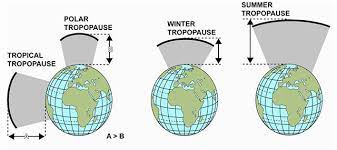Q. Troposphere is a very significant atmosphere layer that determines weather processes. How?
Ans: The troposphere is indeed a crucial layer of Earth’s atmosphere, and it plays a central role in determining weather processes. It is the lowest layer of the atmosphere, extending from the Earth’s surface up to an average altitude of about 8 to 15 kilometers (5 to 9 miles) depending on the location and atmospheric conditions.

1. Temperature Gradient: The temperature within the troposphere decreases with increasing altitude. This phenomenon is known as the lapse rate. On average, the temperature drops by about 6.5°C per kilometer (3.5°F per 1000 feet). This temperature gradient leads to various atmospheric phenomena:
- Convection: The temperature difference between the surface and the upper troposphere drives convection currents. Warm air near the surface rises, cools as it ascends, condenses to form clouds, and releases latent heat, which further fuels vertical motion. This convection is responsible for cloud formation, precipitation, and thunderstorms.
- Pressure Differences: The cooling of air as it rises leads to lower pressure aloft. This difference in pressure creates a pressure gradient force, driving horizontal winds. These winds are the foundation of atmospheric circulation and weather systems.
2. Water Vapor and Condensation: The troposphere contains the majority of Earth’s water vapor, which is essential for weather processes. As warm, moist air rises and cools, water vapor condenses into tiny water droplets or ice crystals, forming clouds. If these droplets grow larger, they fall to the ground as precipitation.
3. Atmospheric Stability and Instability: The vertical temperature gradient and moisture content of the troposphere influence its stability. If the air near the surface is warmer than the air aloft (unstable conditions), it can lead to the rapid upward movement of air, triggering strong convective processes and potentially severe weather events like thunderstorms and tornadoes. In stable conditions, where cold air lies over warm air, vertical movement is suppressed, leading to more stable weather conditions.
4. Frontal Systems and Weather Patterns: Frontal systems, which mark the boundaries between different air masses, are primarily located within the troposphere. These boundaries can lead to the formation of low-pressure systems, cyclones, and anticyclones, which drive weather patterns and changes in wind, temperature, and precipitation.
5. Heat Exchange with Earth’s Surface: The troposphere is in direct contact with Earth’s surface and absorbs and releases heat through radiation, conduction, and convection. This heat exchange is a fundamental driver of temperature variations and local weather conditions.
In summary, the troposphere’s characteristics, including temperature gradients, moisture content, convection currents, and pressure differences, interact to create a dynamic environment that drives weather processes. Its proximity to the Earth’s surface and its role in heat exchange make it a vital layer for understanding and predicting weather phenomena, from short-term changes like thunderstorms to long-term patterns like seasonal variations and climate trends.